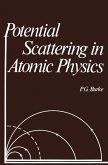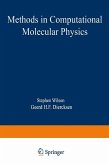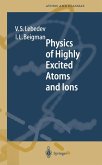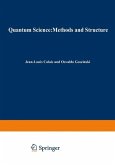Computational Atomic Physics (eBook, PDF)
Electron and Positron Collisions with Atoms and Ions
Redaktion: Bartschat, Klaus
40,95 €
40,95 €
inkl. MwSt.
Sofort per Download lieferbar

20 °P sammeln
40,95 €
Als Download kaufen

40,95 €
inkl. MwSt.
Sofort per Download lieferbar

20 °P sammeln
Jetzt verschenken
Alle Infos zum eBook verschenken
40,95 €
inkl. MwSt.
Sofort per Download lieferbar
Alle Infos zum eBook verschenken

20 °P sammeln
Computational Atomic Physics (eBook, PDF)
Electron and Positron Collisions with Atoms and Ions
Redaktion: Bartschat, Klaus
- Format: PDF
- Merkliste
- Auf die Merkliste
- Bewerten Bewerten
- Teilen
- Produkt teilen
- Produkterinnerung
- Produkterinnerung

Bitte loggen Sie sich zunächst in Ihr Kundenkonto ein oder registrieren Sie sich bei
bücher.de, um das eBook-Abo tolino select nutzen zu können.
Hier können Sie sich einloggen
Hier können Sie sich einloggen
Sie sind bereits eingeloggt. Klicken Sie auf 2. tolino select Abo, um fortzufahren.

Bitte loggen Sie sich zunächst in Ihr Kundenkonto ein oder registrieren Sie sich bei bücher.de, um das eBook-Abo tolino select nutzen zu können.
This unique reference book for graduate students in the field of atomic physics provides a rich source for practical application of advanced quantum mechanics. Numerous suggested problems and ten programs bring the reader to a deeper unterstanding of the theory and methods.
- Geräte: PC
- ohne Kopierschutz
- eBook Hilfe
- Größe: 24.08MB
Andere Kunden interessierten sich auch für
![Potential Scattering in Atomic Physics (eBook, PDF) Potential Scattering in Atomic Physics (eBook, PDF)]() P. G. BurkePotential Scattering in Atomic Physics (eBook, PDF)40,95 €
P. G. BurkePotential Scattering in Atomic Physics (eBook, PDF)40,95 €![Atomic Multielectron Processes (eBook, PDF) Atomic Multielectron Processes (eBook, PDF)]() Viatcheslav ShevelkoAtomic Multielectron Processes (eBook, PDF)160,95 €
Viatcheslav ShevelkoAtomic Multielectron Processes (eBook, PDF)160,95 €![Methods in Computational Molecular Physics (eBook, PDF) Methods in Computational Molecular Physics (eBook, PDF)]() Methods in Computational Molecular Physics (eBook, PDF)72,95 €
Methods in Computational Molecular Physics (eBook, PDF)72,95 €![Physics of Highly Excited Atoms and Ions (eBook, PDF) Physics of Highly Excited Atoms and Ions (eBook, PDF)]() Vladimir S. LebedevPhysics of Highly Excited Atoms and Ions (eBook, PDF)72,95 €
Vladimir S. LebedevPhysics of Highly Excited Atoms and Ions (eBook, PDF)72,95 €![Coherence and Correlation in Atomic Collisions (eBook, PDF) Coherence and Correlation in Atomic Collisions (eBook, PDF)]() Coherence and Correlation in Atomic Collisions (eBook, PDF)40,95 €
Coherence and Correlation in Atomic Collisions (eBook, PDF)40,95 €![Atomic Physics 7 (eBook, PDF) Atomic Physics 7 (eBook, PDF)]() Atomic Physics 7 (eBook, PDF)72,95 €
Atomic Physics 7 (eBook, PDF)72,95 €![Quantum Science Methods and Structure (eBook, PDF) Quantum Science Methods and Structure (eBook, PDF)]() Quantum Science Methods and Structure (eBook, PDF)40,95 €
Quantum Science Methods and Structure (eBook, PDF)40,95 €-
-
-
This unique reference book for graduate students in the field of atomic physics provides a rich source for practical application of advanced quantum mechanics. Numerous suggested problems and ten programs bring the reader to a deeper unterstanding of the theory and methods.
Dieser Download kann aus rechtlichen Gründen nur mit Rechnungsadresse in A, B, BG, CY, CZ, D, DK, EW, E, FIN, F, GR, HR, H, IRL, I, LT, L, LR, M, NL, PL, P, R, S, SLO, SK ausgeliefert werden.
Produktdetails
- Produktdetails
- Verlag: Springer Berlin Heidelberg
- Seitenzahl: 249
- Erscheinungstermin: 29. Juni 2013
- Englisch
- ISBN-13: 9783642610103
- Artikelnr.: 53128515
- Verlag: Springer Berlin Heidelberg
- Seitenzahl: 249
- Erscheinungstermin: 29. Juni 2013
- Englisch
- ISBN-13: 9783642610103
- Artikelnr.: 53128515
- Herstellerkennzeichnung Die Herstellerinformationen sind derzeit nicht verfügbar.
1. Electron-Atom Scattering Theory: An Overview.- Abstract.- 1.1 Introduction.- 1.2 Potential Scattering.- 1.3 Perturbation Approaches.- 1.4 The Close-Coupling Expansion.- 1.5 Computer Program for Potential Scattering.- 1.6 Summary.- 1.7 Suggested Problems.- Acknowledgments.- References.- 2. Core Potentials for Quasi One-Electron Systems.- Abstract.- 2.1 Introduction.- 2.2 Theory.- 2.3 The Algorithm.- 2.4 Computer Program.- 2.5 Test Run.- 2.6 Summary.- 2.7 Suggested Problems.- Acknowledgments.- References.- 3. Energies and Oscillator Strengths Using Configuration Interaction Wave Functions.- Abstract.- 3.1 Introduction.- 3.2 Hydrogen-Like Ions.- 3.3 Two-Electron Atoms and Ions.- 3.4 Many-Electron Atoms and Ions.- 3.5 Configuration Interaction Methods.- 3.6 Transition Probabilities and Oscillator Strengths.- 3.7 The Codes.- 3.8 Examples.- 3.9 Summary.- 3.10 Suggested Problems.- References.- 4. The Distorted-Wave Method for Elastic Scattering and Atomic Excitation.- Abstract.- 4.1 Introduction.- 4.2 Theory.- 4.3 First-Order Amplitudes.- 4.4 Partial-Wave Expansion of the T Matrix.- 4.5 Computer Program.- 4.6 Summary.- 4.7 Suggested Problems.- Acknowledgments.- References.- 5. Distorted-Wave Methods for Ionization.- Abstract.- 5.1 Introduction.- 5.2 Theory.- 5.3 Reduction of the (e,2e) Amplitudes to Computational Form.- 5.4 Computer Program.- 5.5 Summary.- 5.6 Suggested Problems.- Acknowledgments.- References.- 6. The Close-Coupling Approximation.- Abstract.- 6.1 Introduction.- 6.2 Theory.- 6.3 The Numerical Solution of the Close-Coupling Equations.- 6.4 The Born Approximation.- 6.5 Computer Program.- 6.6 Summary.- 6.7 Suggested Problems.- Acknowledgments.- References.- 7. The R-Matrix Method.- Abstract.- 7.1 Introduction.- 7.2 General R-Matrix Theory.- 7.3 Electron-Hydrogen-like Ion Scattering.- 7.4 Computational Solution of the Electron-Hydrogen-Like Ion-Collision Problem.- 7.5 Computer Program.- 7.6 Summary.- 7.7 Suggested Problems.- Acknowledgments.- References.- 8. Momentum-Space Convergent-Close-Coupling Method for a Model e-H Scattering Problem.- Abstract.- 8.1 Introduction.- 8.2 Theory.- 8.3 Numerical Solution.- 8.4 Computer Program.- 8.5 Summary.- 8.6 Suggested Problems.- References.- 9. The Calculation of Spherical Bessel and Coulomb Functions.- Abstract.- 9.1 Introduction.- 9.2 Spherical Bessel Functions.- 9.3 Recurrence Relations for Spherical Bessel Functions.- 9.4 Evaluation of the Continued Fraction.- 9.5 The Programs SBESJY and RICBES.- 9.6 Recurrence Relations for Coulomb Functions.- 9.7 The Program C0UL90.- 9.8 Test Data.- 9.9 Summary.- 9.10 Suggested Problems.- Acknowledgments.- References.- 10. Scattering Amplitudes for Electron-Atom Scattering.- Abstract.- 10.1 Introduction.- 10.2 Definition of the Scattering Amplitudes.- 10.3 Convergence of Partial Wave Expansions.- 10.4 Symmetry Properties of Scattering Amplitudes.- 10.5 Computer Program.- 10.6 Summary.- 10.7 Suggested Problems.- Acknowledgments.- References.- 11. Density Matrices: Connection Between Theory and Experiment.- Abstract.- 11.1 Introduction.- 11.2 Scattering Amplitudes.- 11.3 Density Matrices.- 11.4 Irreducible Tensor Operators and State Multipoles.- 11.5 Observables.- 11.6 2S ? 2P° Transitions.- 11.7 Computer Program.- 11.8 Summary.- 11.9 Suggested Problems.- Acknowledgments.- References.
1. Electron-Atom Scattering Theory: An Overview.- Abstract.- 1.1 Introduction.- 1.2 Potential Scattering.- 1.3 Perturbation Approaches.- 1.4 The Close-Coupling Expansion.- 1.5 Computer Program for Potential Scattering.- 1.6 Summary.- 1.7 Suggested Problems.- Acknowledgments.- References.- 2. Core Potentials for Quasi One-Electron Systems.- Abstract.- 2.1 Introduction.- 2.2 Theory.- 2.3 The Algorithm.- 2.4 Computer Program.- 2.5 Test Run.- 2.6 Summary.- 2.7 Suggested Problems.- Acknowledgments.- References.- 3. Energies and Oscillator Strengths Using Configuration Interaction Wave Functions.- Abstract.- 3.1 Introduction.- 3.2 Hydrogen-Like Ions.- 3.3 Two-Electron Atoms and Ions.- 3.4 Many-Electron Atoms and Ions.- 3.5 Configuration Interaction Methods.- 3.6 Transition Probabilities and Oscillator Strengths.- 3.7 The Codes.- 3.8 Examples.- 3.9 Summary.- 3.10 Suggested Problems.- References.- 4. The Distorted-Wave Method for Elastic Scattering and Atomic Excitation.- Abstract.- 4.1 Introduction.- 4.2 Theory.- 4.3 First-Order Amplitudes.- 4.4 Partial-Wave Expansion of the T Matrix.- 4.5 Computer Program.- 4.6 Summary.- 4.7 Suggested Problems.- Acknowledgments.- References.- 5. Distorted-Wave Methods for Ionization.- Abstract.- 5.1 Introduction.- 5.2 Theory.- 5.3 Reduction of the (e,2e) Amplitudes to Computational Form.- 5.4 Computer Program.- 5.5 Summary.- 5.6 Suggested Problems.- Acknowledgments.- References.- 6. The Close-Coupling Approximation.- Abstract.- 6.1 Introduction.- 6.2 Theory.- 6.3 The Numerical Solution of the Close-Coupling Equations.- 6.4 The Born Approximation.- 6.5 Computer Program.- 6.6 Summary.- 6.7 Suggested Problems.- Acknowledgments.- References.- 7. The R-Matrix Method.- Abstract.- 7.1 Introduction.- 7.2 General R-Matrix Theory.- 7.3 Electron-Hydrogen-like Ion Scattering.- 7.4 Computational Solution of the Electron-Hydrogen-Like Ion-Collision Problem.- 7.5 Computer Program.- 7.6 Summary.- 7.7 Suggested Problems.- Acknowledgments.- References.- 8. Momentum-Space Convergent-Close-Coupling Method for a Model e-H Scattering Problem.- Abstract.- 8.1 Introduction.- 8.2 Theory.- 8.3 Numerical Solution.- 8.4 Computer Program.- 8.5 Summary.- 8.6 Suggested Problems.- References.- 9. The Calculation of Spherical Bessel and Coulomb Functions.- Abstract.- 9.1 Introduction.- 9.2 Spherical Bessel Functions.- 9.3 Recurrence Relations for Spherical Bessel Functions.- 9.4 Evaluation of the Continued Fraction.- 9.5 The Programs SBESJY and RICBES.- 9.6 Recurrence Relations for Coulomb Functions.- 9.7 The Program C0UL90.- 9.8 Test Data.- 9.9 Summary.- 9.10 Suggested Problems.- Acknowledgments.- References.- 10. Scattering Amplitudes for Electron-Atom Scattering.- Abstract.- 10.1 Introduction.- 10.2 Definition of the Scattering Amplitudes.- 10.3 Convergence of Partial Wave Expansions.- 10.4 Symmetry Properties of Scattering Amplitudes.- 10.5 Computer Program.- 10.6 Summary.- 10.7 Suggested Problems.- Acknowledgments.- References.- 11. Density Matrices: Connection Between Theory and Experiment.- Abstract.- 11.1 Introduction.- 11.2 Scattering Amplitudes.- 11.3 Density Matrices.- 11.4 Irreducible Tensor Operators and State Multipoles.- 11.5 Observables.- 11.6 2S ? 2P° Transitions.- 11.7 Computer Program.- 11.8 Summary.- 11.9 Suggested Problems.- Acknowledgments.- References.







